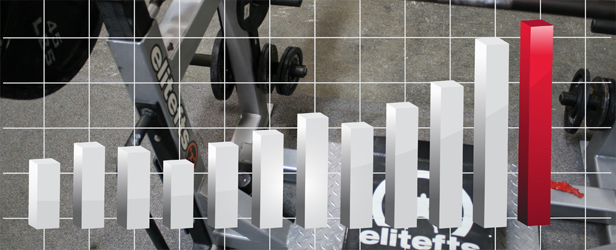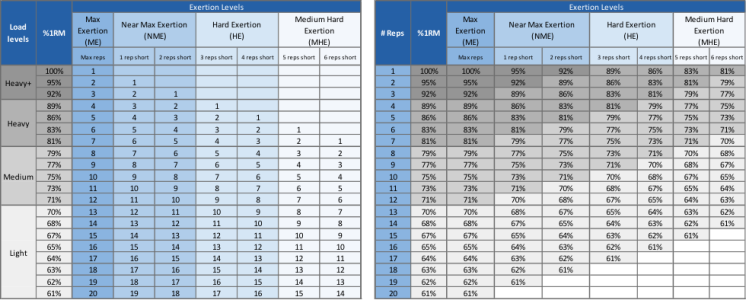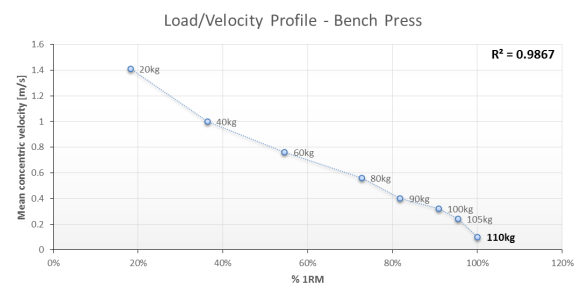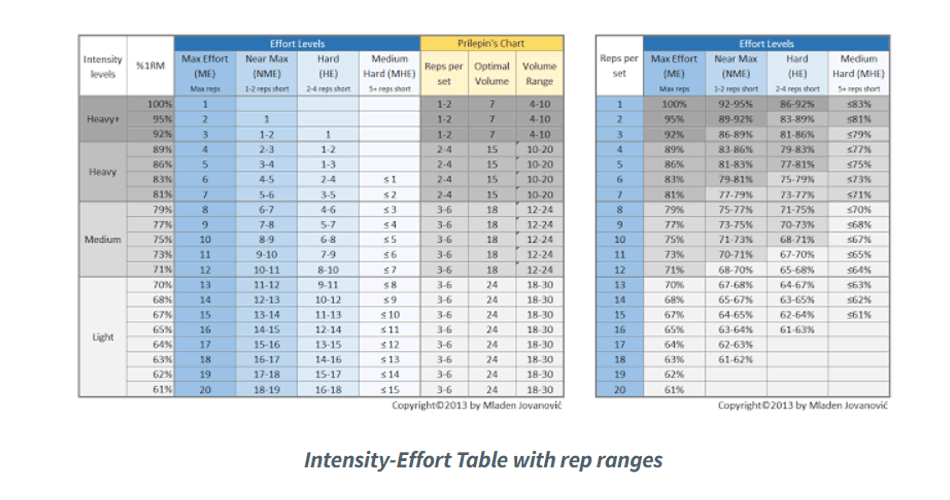Set and Rep Schemes in Strength Training – Part 1
Here is the latest article I wrote for EliteFTS. The article will be published in two parts. Part one deals more with terminology and something that I call ‘intensity trinity’. I hope that this terminology will become standard in our field/industry.
It also explains traditional approach to exercise prescription, know as percent-based approach, along with novel velocity-based approach.
The article’s purpose is to explain the load/exertion table, training process, the difference between “periodization” of training objectives versus training parameters aimed at achieving those objectives and common progressions and variations (set and rep schemes) utilized within training parameters. In my opinion, writers tend to confuse those.
I hope that this article will clear up some terminology issues and provide a very usable load/exertion table that can be utilized to explain various common progressions and variations on the workout, week, and block time-frames.
Enjoy the article and let me know what you think.

Training objectives -> Training parameters -> Variations & progressions
Regardless of your training objectives (increasing strength in specific lifts, increasing strength overall, bulking up, leaning out, rehabilitation, maintenance, etc), key training parameters (intensity, volume, frequency, density) could be varied and progressed on different time scales.
Certain variations and progressions in training parameters are more suited toward different training objectives, but there exist commonalities between them that we will focus on in the current article.
Training parameters usually involve intensity, volume, frequency, and density that could be analyzed and varied on different time-scales, and taking all of them into account would demand a whole book. Hence, the aim of the current article is to provide an overview of the common variations and progressions in intensity and volume only by manipulating set and rep schemes on different time-scales (single workout, week, training block). I know this sounds like a mouthful, but in the next couple of pages, everything will be perfectly clear.
Understanding “intensity”
Depending on whom you ask, there are a couple of definitions of training intensity. To cut the long story short, I will present what I think to be a pretty neat way to understand training intensity and reconcile different definitions and opinions. In my opinion, the intensity has the following three components.
Load – relates to the weight the athlete is lifting in a given exercise expressed as the percentage of his known 1RM (% of 1RM), e.g., if an athlete is performing bench press with 100kg, and his known 1RM is 110kg, then the load is 90%.
Effort – relates to the athlete’s intent to perform a repetition of a given exercise with maximum possible acceleration and speed in the concentric phase. The effort could be maximal (the synonym would be C.A.T. – compensatory acceleration training) or it could be submaximal (lifting with certain tempo)
Exertion – relates to the proximity of failure in a given set. It seems reasonable that the degree or level of exertion is substantially different when performing, e.g., 8 of 12 possible repetitions (12RM) with a given load (8[12] or 8 of 12) compared with performing the maximum number of repetitions (12[12] or 12 of 12). Exertion, in strength coaches’ jargon, is usually expressed as “reps left in the tank”. Using the previous example, performing 8 reps with 12RM load represents submaximal exertion with 4 reps left in the tank. Performing 12 reps with 12RM represent maximal exertion with no reps left in the tank.
All three represent inter-related components of training intensity. I love to call it Intensity Trinity.

Now you have the tool to answer questions such as “What is more intensive – lifting 90% for 2, or lifting 75% for 10?” Hint: one involves higher load and another involves higher exertion.
Understanding Load/Max Reps relationship
All lifters are familiar with the fact that they can only perform a certain maximal number of reps with certain load on the bar. If we express load on the bar as a percent of maximal load that could be lifted (% 1RM) and we assume maximal exertion on the last rep (no reps left in the tank) we get Load/Max Reps relationship. There are numerous tables that quantify this relationship, but for the purpose of this article, I will use Dan Baker’s table for experienced trainers.

Using this table one can know how many maximal reps can be performed using a certain load (% 1RM) and also, one can predict maximal load that can be lifted (1RM) using maximum performed reps and reconverting factor. For example, if one performs 10 reps with 225lb, his predicted maximum is 225×1.33 (reconverting factor), which is around 300lb. Please note that this table is different for different lifters and lifts, so take this as a rule of thumb and try to create your own table [1].
Understanding Load/Exertion relationship
A load/Exertion relationship is another crucial concept for understanding strength training. From the Load/Max Reps table we know the maximum number of reps that can be performed using different loads. This of course represents maximal exertion. What we want to do next is to quantify the relationship between load, number of reps, and exertion level (expressed as reps left in the tank).
The following table is one such solution using the mentioned Load/Max Reps from Dan Baker. I simply call it Load/Exertion table.

Even if you see two tables, this is only one table organized in two ways for easier utilization. For example, if one plans using 75% of 1RM but is not certain what number of reps should be performed for a given exertion level, the table on the left can give him an answer. On the flip side, if one plans to do 5 reps per set, but it is not certain what % of 1RM to use for a given exertion level, the table on the right can give him the answer.
The Load/Exertion table represents a crucial concept for understanding different variations and progressions (or set and rep schemes) we are going to cover.
Understanding Load/Velocity relationship
Suppose one performs single repetitions across range of loads (e.g. from 30 to 100% 1RM) with maximal effort. The higher the load, the lower the achieved velocity of the movement in the concentric range.

What is interesting is that Load/Velocity relationship could be modeled with a simple linear model (a.k.a. a line with slope and intercept) and remains very stable across time. In plain English, what this means is that 80% of 1RM will have very similar velocity no matter the change in 1RM (increased or decreased). Along with that, velocity associated with 1RM (e.g. 0.15 m/s for bench press and 0.3 m/s for squat) is very similar across subjects with different 1RMs and very stable across time (if one improves or decrease his 1RM). This opens up great number of options for coaches.
Understanding Velocity/Exertion relationship
Suppose one performs reps to failure across different loads (e.g. 50, 70, 90% 1RM) with maximal effort. There are couple of VERY interesting concepts emerging.
The first one is that the velocity of the last rep in a set to failure (regardless of load use) is very similar, if not the same as velocity associated with 1RM. In other words, the last rep in the 10RM set will have a very similar velocity to 1RM rep.
The second one is that velocity associated with “reps left in the tank” (exertion level) will be very similar across loads. In plain English, my 8th rep with 10RM load (2 reps left in tank) will have very similar velocity to my 4th rep with 6RM load (2 reps left in tank).
Load/Velocity and Velocity/Exertion relationships and hence profiles for each athlete represent a novel and very powerful concept that is utilized in velocity based strength training – a way to prescribe, monitor and auto-regulate strength training.
These two relationships are of not great importance for the current article (since we are going to cover set and reps schemes with traditional approach to strength training prescription), but those who are interested in learning more can click HERE.
Understanding “Traditional Approach”
The traditional approach, as I love to call percent-based approach involves prescribing strength training using percentages and known (or estimated) 1RM of the lifter.
The whole process goes like this: athlete knows his 1RM in a particular exercise or he tests it either using a 1RM test or reps-to-failure test and estimates 1RM using reconversion factors (see Load/Max Reps table). Then he uses percent-based programs (e.g. 5×5 with 75%) and coverts percentages to absolute loads (e.g. 5×5 with 120kg). And then he goes lifting for a couple of weeks. Then either increase 1RM for some small amount (e.g. 5lb) or test it either with 1RM test or with an open set (basically reps-to-failure, usually done on the last lest inside the training program/cycle). Rinse and repeat (or switch to another program).
Without going into too many details, there are a lot of problems with this approach. There are solutions as well.
The biggest problem is the lack of adjustment for different rates of changes for different lifters. Another problem is the lack of auto-regulation on a daily basis, for both good and bad days.
One of the simplest solutions is prescribing ranges for either load or number of reps. For example, instead of prescribing 5×5 with 75%, one could prescribe 5×5 with 70-80% or 5×4-6 with 75%. This takes into account good or bad days and reduces daily expectations and anxieties of the lifter for hitting certain numbers.
A bit more complex solution is using subjective feedback for exertion level for each set. This involves prescribing exertion levels and omitting either load or number of reps. Mike Tuchscherer, world-class powerlifter, developed the whole system revolving around RPE (Rating of Perceived Exertion) which is an easy way to quantify exertion level (RPE10 = no reps left in the tank, RPE9 = 1 reps left in the tank, RPE8 = 2 to 4 reps left in the tank and so forth). So, instead of prescribing exact load and reps, one could prescribe load and exertion level (3 sets with 80% @RPE8) or the number of reps and exertion level (3×5 @RPE8).
More attuned lifters can use this subjective feedback (rating of perceived exertion) to auto-regulated for good and bad days and adjust for individual rates of change in the strength. It takes time and hard work (and a lot of trial and error) to develop such knowledge.
The novel method involves using velocity-based strength training prescription and control. Describing this approach is beyond the scope of this article, but in short, it revolves around prescribing initial rep velocity and velocity stop, instead of %1RM and number of reps. Again, for more information click HERE.
Even with all these flaws, traditional or percent-based approach is still the most dominant approach to strength training. It was important to introduce the above relationships between load, exertion, and effort, along with the problems of percent-based approach to get the big picture, but for the rest of this article we will focus on common variations and progressions (set and rep schemes) under the percent-based umbrella in part 2.
How to Implement This in “Real Life”?
Since the time this article was published on EliteFTS, I was working on translating the above-mentioned set and rep schemes into a ready-to-use Excel template, for both team/group workout and individual programs.
The good news is that we have recently released a newly redesigned version of Strength Card Builder, which now includes more than 1900 set and rep schemes from the Strength Training Manual Books (Volume 1 & Volume 2).
Here are the PDF previews of the Strength Card Builder outputs:
If you want to know more about SCB, check out the two short videos below:
Demo Video (version 5.0)
Instructional Video (version 5.0)
The new version of SCB can be downloaded for free by Premium members, as well as Standard members who have been in our community for over a year. All Standard members who are with us less than a year will also be able to download SCB free of charge, as soon as they fulfill a condition above.
If you are currently not a member of the Complementary Training community, I would like to invite you to become one.











Responses